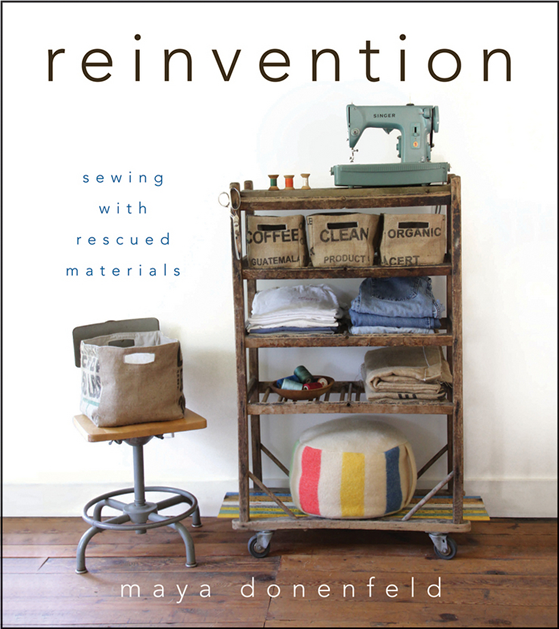Reinvention: Sewing with Rescued Materials is a beautiful book. The cover’s texture and inks are reminiscent of natural materials, giving a consistent “feel” to the book. The construction is also well thought-out; it’s a hardcover for longevity, but it’s spiral-bound so it will lie flat while you work on projects.
I was a little disappointed, though, that it wasn’t quite what I expected. When I read “sewing with rescued materials,” I expected projects that would make use of specific (but hopefully common!) items that are often discarded. You may have seen tutorials for things like an apron from an old pair of blue jeans (that takes advantage of the waistband and pockets). This is the sort of thing I was expecting, but it’s not what the book contains.
Rather, the book is a serious of patterns categorized by the type of material: linen, burlap, jersey, wool, denim, mailers (Tyvek), vintage. Patterns include a scarf, pillows, portfolio, bags, onion/garlic sacks, log carrier, inspiration board, burlap bin, accessories, aproned skirt, throw, trivet, insulated lunch sack, poufs (for seating), toys, oven mitt, rug, hammock, zip pouch, banner, notebook, luggage tags, lingerie case, blouse, and moveable hamper. (Thereis a picture in the very front of the book of a scarf that appears to be made from an old pair of pants in the general manner I had anticipated, but as far as I can tell, the instructions for it aren’t in the book.)
If you can simply avoid expecting the book to be something it’s not, it does have some useful information in it. A couple introductory chapters introduce sewing and other techniques that are needed throughout the book. Each textile chapter opens up with a history of the fabric and a description of where it can be found. It then tells you how to deconstruct the “original” items, offers tips for working with that particular fabric type, and briefly tells you what its environmental impact is.
Every project is illustrated with lovely full-color photographs, and most, if not all, include diagrams, as well, within the step-by-step instructions. Plenty of specific tips are included for executing things that might be tricky (for instance, how to mark quilting lines), as though you were working through the project with a friend at home.
All in all, this is a nice, high-quality book with patterns that will appeal to the eco-friendly. Just don’t expect it to be a “how to use those old jeans” sort of book. 🙂
Disclosure: I was provided by the publisher with a copy of the book to facilitate this review. As always, all opinions expressed here are entirely my own.
Tyvek is a registered trademark of DuPont.

Leave a Reply